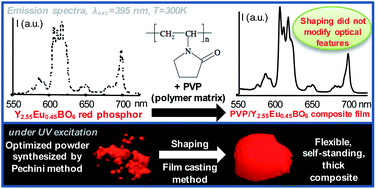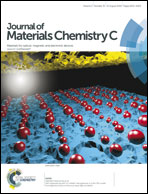Investigations on PVP/Y3BO6:Eu3+, a red luminescent composite for lighting devices based on near UV-LEDs
Abstract
This work deals with a red phosphor, Y3BO6:Eu3+, and its corresponding poly(N-vinylpyrrolidone) (PVP)/Y3BO6:Eu3+ luminescent composite film suitable for applications in the next generation of Hg-free lamps based on near ultraviolet (UV) light emitting diodes (LEDs). Well crystallized samples of Y3BO6 powders with the Eu3+ content up to 20 mol% were prepared by the Pechini method. After structural, morphological and optical characterization, the best doping rate of Eu3+ in the matrix was determined to be 15 mol%. This optimal powder, which is highly friable, was easily ground into fine particles and homogeneously dispersed into a PVP polymer solution to give rise to a polymer phosphor composite. Structural and optical features of the composite film have been studied and compared to those of a pristine PVP film and Y3BO6:Eu3+ powder. All the characterization (XRD, SAXS, luminescence…) proved that the red phosphor particles are well incorporated into the polymer composite film which exhibited the characteristic red emission of Eu3+ under UV light excitation. Furthermore, photostability of the polymer/phosphor composite film under UV-LED irradiation was evaluated from exposure to accelerated artificial photoageing at wavelengths above 300 nm.


 Please wait while we load your content...
Please wait while we load your content...